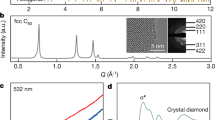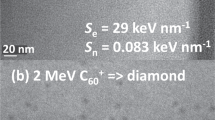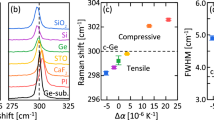Abstract
When a thin foil of amorphous germanium is crystallized by a pulsed laser beam1, an electron beam or by vacuum annealing2, the resulting polycrystalline matrix has the diamond cubic transmission electron diffraction pattern shown in Fig. 1. However, we have recently obtained crystal lattice images from some of the crystals in this polycrystalline matrix which had interplanar angles that were not characteristic of a diamond cubic structure. We now resolve this problem by demonstrating that crystals in the polycrystalline matrix had either a hexagonal or a diamond cubic crystal structure.
This is a preview of subscription content, access via your institution
Access options
Subscribe to this journal
Receive 51 print issues and online access
$199.00 per year
only $3.90 per issue
Buy this article
- Purchase on SpringerLink
- Instant access to full article PDF
Prices may be subject to local taxes which are calculated during checkout
Similar content being viewed by others
References
Andrew, R. & Lovato, M. J. appl. Phys. 50, 1142–1144 (1979).
Parsons, J. R. & Balluffi, R. W. J. phys. Chem. Solids 25, 263–272 (1964).
Yin, M. T. & Cohen, M. L. Phys. Rev. Lett. 45, 1004–1007 (1980).
Tan, T. Y., Foll, H. & Hu, S. M. Phil. Mag. 44, 127–140 (1981).
Author information
Authors and Affiliations
Rights and permissions
About this article
Cite this article
Parsons, J., Hoelke, C. Crystallography of hexagonal germanium. Nature 301, 591–592 (1983). https://doi.org/10.1038/301591a0
Received:
Accepted:
Issue date:
DOI: https://doi.org/10.1038/301591a0
This article is cited by
-
Nanocrystalline wurtzite Si–nickel silicide composite thin films with large band gap and high resistivity
Journal of Materials Science (2011)



